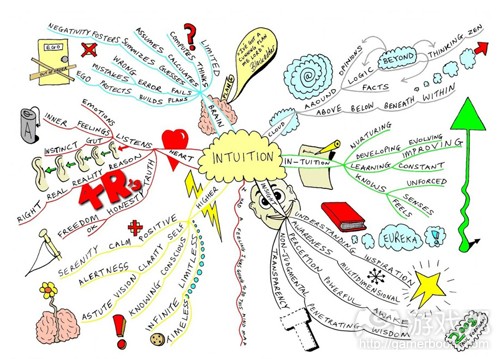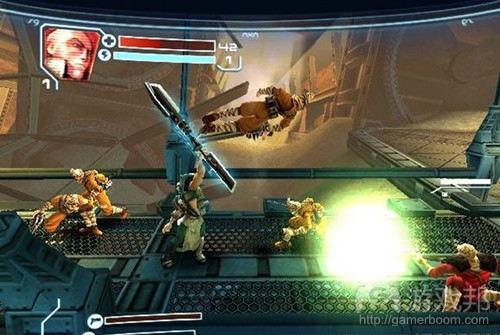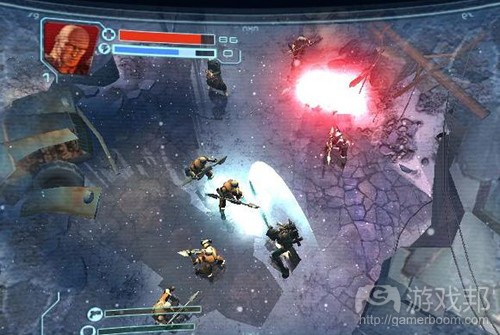从心理及文化角度解析游戏界面设计原理
作者:Ara Shirinian
电子游戏的一大特性便是玩家经常根据自己是否能够轻松玩游戏而判断它的好坏。比起其它消费娱乐形式,电子游戏更像是一种体育运动,总是要求玩家只有具有一定的执行能力才能真正感受到游戏多样的操作乐趣。而我们也总是能够在刚开始玩游戏时便感受到游戏是简单还是复杂。
有些游戏非常容易理解。不管它是否拥有明确的教程,玩家也都能够一眼看出自己该做些什么,游戏的基本规则是什么,什么是有帮助的什么是对立的,以及自己该如何执行任务以完成目标等。
面对这类型游戏,玩家一开始便知道自己能够玩游戏。他们不需要耗费额外的精力去思考如何应对游戏的基本机制,而只要根据自己的想法开始游戏,便会立刻深陷游戏的魅力中。他们所经历的各种难题也都是这些游戏的固有属性。
当然也存在一些让人困惑的游戏。当玩家开始玩这类型游戏时,他们并不清楚自己是否有能力应对游戏,而他们也将因为自己的不理解而遭受各种惩罚,并且需要不断猜测游戏所提供的各种线索和符号的含义(但是大多数情况下会发现自己的想法都是错的)。
玩家需要耗费更多时间去思考“如何玩游戏”。如果你是一名骨灰级玩家,你可能会不断地发出“这到底是什么鬼东西?”或者“为什么这里会出现这种该死的东西?”等抱怨。
当然了,我只是简单地列举出两个极端的情况,大多数情况下游戏体验都是混合着直观和非直观性内容。我将在本文进一步讨论为何有些内容带有直观性,而有些内容却没有,以及不同的人对于电子游戏设计中的直观性以及含义又有何不同看法。
直观性测试1
为了能够以一种熟悉的方式进行交流,并更完整地呈现这些机制的运作原理,我将在文中一些非电子游戏案例进行说明。我们将在此研究的一些心理理念同影响人们与界面互动的概念是相一致的。而电子游戏只是刚好使用了这些对我们来说非常重要的理念。
让我们假设展现在你眼前的是两个不同的GUI设置。在图1a中,我们将看到一个Mystery GUI A,并且会发现“取消”按钮总是在“保存”按钮的左边。而在图1b中,我们看到的Mystery GUI B的按钮则呈现出完全相反的布局,即“取消”按钮是在“保存”按钮的右边。
到底哪种设置更具有直观性?为什么?值得一提的是,Mystery GUI A就是Mac GUI的标准,而Mystery GUI A则是Windows GUI的标准。如此看来这一例子也就显得更有趣了,因为两大最出名的计算机GUI界面却使用了完全相反的两种标准设置。
直观性测试2
另外一个有趣且更能够体现直观性的例子便是标准的传统键盘(QWERTY)以及德沃夏克键盘(Dvorak)布局的比较。QWERTY是最古老的一种键盘布局,它的存在已经长达140多年之久。而Dvorak尽管对于硬核玩家来说较为陌生且新颖,但是它也算是一种较为古老的发明了(算上去也有80岁高龄了)。
当我让别人选择一种更具有直观性的键盘布局时,他们总是会指向QWERTY。而当我询问原因时,他们的普遍说法也都是因为更加习惯于QWERTY的布局。
但是极具讽刺的是,Dvorak的布局能够大大缩小手指的移动范围而提高打字速率,这也是这种键盘的设计理念。
表明上来看是Dvorak拥有比QWERTY更高的执行力,因为它是以提高用户的打字速度而出名——但是在不同情境下这种键盘布局比起竞争对手QWERTY仍然存在着更多挑战因素。
不管怎样,对于那些从没使用过任何键盘的用户来说,也就无所谓哪种类型的键盘布局更具有直观性了。
我们之所以喜欢QWERTY是因为我们一直都在使用这种键盘布局。基于过去使用这种键盘的经验,我们很清楚每个按键的布局,甚至能够闭眼打出任何单词。如此看来,可以说我们所感受到的直观性是来自于个人经历或在培训中所学习到的部分功能。
个人经历非常强大,特别是当你遭遇一些异常境况时,你更能够感受到它的强大力量,因为这时候你的心里总是会浮现出对于该境况的直接与隐性的期望。基于它具有多样的效果,我便将其称为“认知包袱”,但是事实上这种效果总是与个人经历,过去的经验以及培训等内容直接相关。
换句话说,你在判断何种内容更有意义,你是否理解这一内容或者你对它有何种想法等都是你个人认知包袱中的一大功能。更重要的是,当你在玩任何一款电子游戏时你都会随身携带这一“包袱”。当一款游戏能够有效地配合你的认知包袱时,你便会觉得这款游戏是容易玩的或者是容易学习的;而当一款游戏背离了你的认知包袱,你也会说这款游戏太让人沮丧或者困惑。
电子游戏的认知包袱
2004年,我正致力于《红星》的设计(游戏邦注:该游戏最终于2007年发行于PlayStation 2)。那时候我们总是邀请一些从未看过我们游戏的新玩家(但是他们却玩过其它游戏)帮我们进行游戏测试,并观察他们的反应(且不会在他们的游戏过程中与之交谈)。当然了,如果能够在游戏开发过程中而非发行后进行这种测试效果会更好。
《红星》是一款基于角色的混战和射击类行动游戏,包含了一系列线性关卡。某些关卡使用了侧景视图,而某些则使用俯瞰视图。我并不会每次都为那些没玩过游戏的玩家呈现出相同的初始关卡,但是碰巧游戏的第一个关卡是始于侧景视图,而第二个关卡才是俯瞰视图。
我发现一个很有趣的事实是,玩家总是希望自己的角色能够在游戏中跳跃,但是这却是取决于玩家最初所选择的关卡!为何玩家在此会迫切地希望进行跳跃?因为在《红星》中玩家并不能执行传统的跳跃运动。只有一些特别的混战攻击会反弹在玩家身上而促使他飞跃起来;实际上,在这款游戏中跳跃并不属于游戏机制中的组成内容。
如果玩家一开始选择的是侧景视图关卡(如图2a),他们便会产生“跳跃按钮在哪里?”或者“为何我不能跳跃”等疑惑。
而如果玩家最初选的是俯瞰视图关卡(如图2b),他们便不会再抱怨不知道如何跳跃或感到其它疑惑了——即使他们在这之后接触到侧景视图关卡。
这是为什么?许多玩家,特别是那些伴随着8位或16体横向卷轴游戏长大的玩家总是带着一种认知包袱,即他们会认为“角色类游戏也就是横向卷轴游戏总是会设有跳跃按钮”,并且在看到更多具有相同标准功能的游戏后,这类型玩家的认知包袱也变得越来越沉重。而与此相反的是,大多数突出俯瞰视图的游戏都未设置角色跳跃的功能——特别是在8位以及16位游戏流行的那个时代。
因此可以说,侧景视图允许玩家在游戏中进行跳跃而俯瞰视图却不行。就像单看侧景视图截图我们便可以看到一个垂直的屏幕空间,并且很容易想象角色在此进行跳跃。毕竟,大多数这类型游戏都允许你能够跳跃,你自然会觉得这款游戏亦是如此。
而当你第一次看到俯瞰视图截图时,你会发现它的垂直维度已经被压缩至最上方,所以你找不到任何允许角色跳跃的物理空间,特别是当你的视图是垂直向下时。所以你自然也会觉得在这类型游戏中角色并不能进行跳跃。
功能可见性
这一特殊术语在1990年被Don Norman使用后迅速得到了推广,他说道:
“功能可见性是指某件事物的认知和实际属性,并且主要是指那些能够决定其可能用途的基本属性。”
在这里,“事物”也就是指任何具有实用性的物体,而它的功能可见性便是它的使用方法。
其实早在1977年,J.J. Gibson便首次提出了这一术语,但是那时候Gibson并未意识到它的认知性。
对于Gibson来说,如果一个物体具有实用性,那么它便具有功能可见性——而不管你是否这么看待它。但是为了解决现在的问题,我们就必须明确区分认知功能可见性与实际功能可见性。
假设我们拥有一把折叠椅,那么大多数人会认为它的功能可见性是:我们能够坐在上面,能够将东西放在上面,踩在上面去够着某物,或者将其折起来方便储存。
认知功能可见性也可以说是一种文化传承功能或者认知包袱。举个例子来说吧,如果你是一名职业摔角选手,当你看到一张折叠椅时你所想到的认知功能可见性可能是:这是用来投掷的物体,用于压制的平台,并且能够举起它朝对手砸去。
我们也可以进一步拓宽思维去看待功能可见性——尽管人们很少这么做。例如,自行车的一般功能可见性是旋转轮子而进行移动;但是如果你使用方轮去组装自行车,它便不再具有旋转的功能可见性。
而如果你再换成安装八边形轮子,自行车便能够再次移动起来,虽然效果可能没有圆形轮子好。在《GT赛车5》中,每一款车子都具有严格的驾驶功能可见性,但是实际上它们的驾驶性能却具有很大的不同,例如具有灵活的前轮驱动装置的Honda Civic Type R,强大且灵敏的1966 Shelby Cobra 427,或者马力高达1500的Red Bull X2010。
认知功能可见性vs.实际功能可见性
在折叠椅例子中,我们列举出了许多认知功能可见性。巧合的是,这些认知功能可见性在这个例子中也是它的实际功能可见性。但是如果认知功能可见性不同于实际功能可见性又会是何种情况?
让我们先研究图3a中的水槽橱柜。我们可以看到在台面下方有三个抽屉。而因为看到每个抽屉中央设有把手我们便知道它们的认知功能可见性是往外拉。
为了证实我们的想法我们便需要去拉这些抽屉,但是这时候我们会发现如果选择了旁边两个抽屉,就能成功将其拉出来;但是如果我们去拉动中间的那个抽屉,它却不会动。
这并不是一个真正的抽屉,因为里面设有一个下陷的水槽,已经没有多余的空间再安置一个抽屉。它只是被设计为一个抽屉的样子。也就是它的认知功能可见性是往外拉,但是实际上它却未具有这种功能可见性。所以当认知功能可见性与实际功能可见性出现矛盾时,问题便会浮现出来。
在这里,我们能够通过创造一个不会引起往外拉认知功能可见性的橱柜外观。也就是像图3b那样,没有人会认为台面下方的那片雕花盖板理解为具有可往外拉的功能。
再次回到之前《红星》中的视图案例中,如果将“拉”换成“跳跃”,我们会发现水槽橱柜的问题也就是功能可见性的数量和类型的问题。假造了抽屉的水槽橱柜就像是侧景视图级别,即尽管玩家所具有的认知功能可见性是跳跃,但是他们却不能在游戏中真正进行跳跃;而加了块盖板的水槽橱柜就像是俯瞰视图关卡,即玩家不会在此产生跳跃的认知功能可见性,而游戏也的确不具备跳跃功能。
如果我们想纠正这一错误,我们便应该让玩家先从俯瞰视图关卡开始游戏,如此即使后来转变到侧景视图关卡时,玩家也不会再期待能够在游戏中进行跳跃了。
当玩了一个关卡的游戏后,玩家便基本上了解了游戏的实际功能可见性,并且不会再根据其它类似的游戏去安插错误的认知功能可见性。但是这时候我们需要解决的问题是:我们在第一个关卡会因此失去多少玩家?那些没有耐心和足够精力的玩家是否还会尝试这看似具有跳跃功能的游戏?
认知包袱vs.自然映射
早前的经历,培训或包袱不只是我们产生认知功能可见性的唯一动力。这里还存在关于自然映射的理念,Norman对此做出了详细的解释。
首先,让我们看看他对一般情况下的映射的定义:
“映射是一个技术术语,指的是两样物体之间的关系,如此看来也就是控制,移动以及对于世界的影响之间的关系。”
就像在《超级马里奥兄弟》中,方向键盘中的右键头便是用于移动马里奥向右前进。所以我们说右键按钮能够映射出马里奥朝右行。或者是在QWERTY键盘布局中,你的左手小指下方的按键通常会自然映射出字母A。所以,到底是什么促成这种自然映射?
Norman定义了自然映射可能具有的4大特征:
1.自然映射可能使用物理或空间类比方法
火炉控制装置的设置便是空间类比的一个典例。观察图4a中的火炉,你该如何判断哪个旋钮控制着哪个燃烧器?这里的自然映射是因为旋钮的空间布置与燃烧器的空间布置完全一致;也就是左边旋钮控制着左边的燃烧器,而中间的旋钮控制着中间的燃烧器,以此类推。
图4b列举出了一个未使用空间类推方法的火炉界面。到底是哪个旋钮控制着左上方的燃烧器?是第一个旋钮还是第二个?或者是后两个中的一个?唯一知晓答案的方法便是通过实践进行验证。
2.自然映射可能利用文化标准
观察图5的音量旋钮,如果我说调大音量,那么你会怎么做?我想大多数人都会朝顺时针方向进行旋动;他们这么做当然是对的。即使没有明确的标签进行说明,从文化标准来看我们也知道顺时针旋动按钮意味着“调大”,而逆时针则意味着“调小”。
对于PC玩家来说,文化标准将会映射出方向键是用于控制角色的移动,此外也能够利用特殊的空间类比进行映射(游戏邦注:如按压A键也能够控制着角色朝左前进)。但是对于那些不熟悉这种文化的玩家来说,即使他们再热衷于游戏,也很难轻松地使用这种方向键。
除了空间类比,输入法等也会要求玩家最好能在执行前拥有足够的经验。一般看来比起寻常界面,电子游戏更主要是依赖于这一点——因为时间限制:我们不需要朝着一个正确的方向转动旋钮或者调到一定的量,但是在打钻块游戏中,游戏却会要求玩家这么做。
3.自然映射可能利用“生物学”元素
这应该是自然映射四大特征中最模糊的一个吧。生物学元素是指映射类比具有一定的生物基础。例如“大声点”会自然映射出“更多”。但是这种方法并未频繁出现在游戏中,也就是一般情况下我们不会将更高的音调与“更多”联系在一起。
但是也出现了一些针对于此类别的深奥研究,如Christopher Wickens(游戏邦注:美国伊利诺大学航空研究所主任)发现当任何刺激物或反应出现于人类大脑的某一边时,飞行员便能够更快捷且更准确地做出反应(就像你的右眼注意到某个物体时你便会立刻使用右手做出反应)。
4.自然映射可能利用认知原则
这是针对于某些理念而言,如控制器的物理排序——即基于功能的接近性,视觉分组或者优先排序等。举个例子来说吧,大多数汽车的空调系统都带有温度控制器,风扇控制器以及排气控制器。而在此关于这些控制的自然映射便在于每个功能分组也将反应其本身所具有的物理功能;也就是将所有的排气控制器集中在一起,将风扇控制器以及温度控制器各自相对应地集中在一起。
既然我们理解了自然映射的相关特征,接下来我们可以以QWERTY键盘为例子进一步解析Norman列表中的这些功能。
1.这里不存在任何物理或空间类比方法,但是数字和字母却拥有一定的逻辑顺序:字母数字顺序。
第一排的数字顺序便是使用这一原理,并且大多数可替代的键盘布局都是使用与第一排数字相同的顺序。而字母却不是这样。
如果盲目地遵循这一理念,我们可能创造出一款只有一行字母并且是基于字母数字顺序的键盘——但是很明显这不是一个好的理念;如此所造成的各种笨拙体验将大大掩埋了基于逻辑所创造出来的优势。
还有一种符合逻辑的选择便是依照字母顺序的键盘,并且是基于传统纵横比而罗列出三行。这是一种次优选择,不过对于那些完全未接触过键盘的用户来说,比起随机布局,按照字母表顺序的布局更具有性能优势。
2.广为人知的QWERTY键盘布局便是一大文化优势。如今我们大多精通于使用QWERTY键盘,并且这种键盘布局也总是出现在人们所使用的各种设备的输入文本中,除了一些临时便携设备或娱乐设备。
3.在这个案例中并不存在任何生物学元素能够加以说明。
4.在这个案例中,因为大多数按键的功能和作用都是相等的,所以我们很难进行功能性或认知性分组。不过有趣的是,Dvorak键盘将所有的元音字母集中在中间行的最左边——主要是出于两个原因:第一便是将使用频率较高的元音字母集中在手指会自然放置的最大化中间行是Dvorak用户用于提高打字效率的重要方式。也就是在Dvorak键盘中,几乎70%的字母都是集中在最大化中间行上。
第二,因为元音字母总是与辅音字母交替出现,并且很少会连续出现多个元音字母,所以限制一只手去打出元音字母便能够提高每只手打字的平衡性。一般情况下,两手顺序交替打字总是比只用一手的性能高。而就像之前提到的,键盘中的数字总是集中罗列在一起,这便是一种明智的认知分组。并且在更小范围内,不管是Dvorak还是QWERTY对于标点字符的设置也都几乎相同。
达到预期效果
最后,我们便可以就自然映射和认知包袱做出一些有趣的推论。就像我们所列举的键盘例子,我们知道并不是任何一种技术都能够创造出一种可被使用的自然映射。事实上,当你为一款电子游戏设计了一个控制界面时,你也不可能保证就会创造出一种自然映射;这主要是取决于你的设计风格。
因为玩家界面是任何游戏设计中至关重要的一部分,所以有时候你的游戏设计中会不可避免地出现一些现实问题,比如你不能将这种界面与自己的设计相融合。在这种情况下,你得让设计风格让位于界面设置。因为玩家总是会在体验你的视觉设计之前先体验界面,并且取决于界面的好坏,他们可能不会遵循你的预期想法去体验你的设计。
实际上,文化标准只不过与人们所拥有的相同认知包袱或培训相关。也有些文化标准的范围更加广阔——例如整个技术世界也就是一个文化范畴,在此人人都能够理解QWERTY的布局。也有一些较小的文化范畴,例如PC游戏玩家知道不同方向键所代表的意思。
早前的资深射击类游戏玩家对于角色设计检测盒的了解便是一种较小的文化范畴,而对于自己角色的了解则属于更小的文化(但是这却不会影响角色“命中目标”的技能对于游戏可玩性的价值),除此之外,这种文化范畴也会随着时间的变化而变化——即使是从个人层面来看。
事实上,不管是文化标准还是认知包袱都可以根深蒂固地存在于玩家心中,影响着他们执行任何行动,甚至能够压倒其它自然映射方法。QWERTY的普及及其易用性便是得益于文化优势。对于数字1和3的自然映射并未起到任何作用,但是在Dvorak键盘中数字4却发挥了很好的功效。然而,Dvorak的所有优势却始终比不上QWERTY的一个易用性。
而在游戏开发中“观察性”游戏测试之所以如此有效便是因为文化元素及其优势。对于不会遭受任何外部影响的游戏测试来说,它将能够有效地揭示出玩家的文化知识和期待,甚至是他们个人的认知包袱。
当我们获得了玩家关于自己游戏体验的合理反馈时,我们必须先理解他们的认知包袱和文化知识才能真正理解这些反馈的意义和重要性。如此我们便能够根据玩家的文化更好地调整游戏,并最终推动玩家在我们的期望下轻松地进行游戏。
但这也不意味着最佳发展方法就是最大限度地使用最大的文化标准。可能这样能够让你在短期时间内留住玩家,但是你却不可能再提供给玩家更多创新体验,或者你可能因此牺牲其它有意义的游戏元素。就像设有双重虚拟摇杆的《枪之女神》以及负载有大量按钮控制器的《重铁骑》便是迟钝且出乎意料的控制方案之典例。但对于那些具有足够耐心并且愿意克服界面障碍的玩家来说,这却也不失为一种颇有深度的游戏体验。
在我们开发的每一款游戏中,我们总是以各种方法不断地强化,推进文化标准,甚至有时候也需要与之相抗衡。同时我们也始终根据某种方向去操纵着游戏开发过程,尽管在近几十年内还不一定能够看到结果。我们希望所有玩家都会觉得我们的游戏具有易用性,但是有时候为了能够呈现给玩家一些新颖,有意义且具有吸引力的游戏玩法,我们也需要事先分解玩家们的文化标准并做出适当分析。
(本文为游戏邦/gamerboom.com编译,拒绝任何不保留版权的转载,如需转载请联系:游戏邦)
Intuition, Expectations and Culture: Learning from Psychology to Build Better Game Interfaces
by Ara Shirinian
One peculiarity of video games is that we often think of them in terms of “games we are able to play” and “games we are not able to play.” Much like a sport, and unlike most other forms of consumer entertainment, video games typically demand some standard of performance ability before the player can even begin to enjoy their various workings. From the very moment we start playing a game, we develop an impression of how easy or hard a time it’s going to give us.
Some games are quite easy to understand. Regardless of whether there is an explicit tutorial, players instantly intuit what to do, what the basic rules are, what is good, what is bad, and how to go about doing the various things that can be accomplished.
They feel like they’re capable of playing the game from the first moment. They don’t really expend a lot of effort figuring out how to operate the basic mechanics of the game, they “just do it,” and find themselves immediately engaged. Any problems and difficulties they do experience are intrinsic to the game.
Conversely, other games seem to be bewildering and obtuse. When you play those games, your capabilities are unclear, you find yourself punished for reasons you don’t understand, and you take guesses (often to find out you are wrong) about what various cues and symbols mean.
You spend far more time thinking about “how to work” the game. If you’re an experienced gamer, you’ll often ask yourself questions like “What the hell is that?” or, “Why the hell is this here?” — substituting your favorite expletive for “hell.”
Of course, I have just illustrated two extreme situations, and most gameplay experiences have some mix of intuitive-feeling things and counterintuitive-feeling things. In this article, I’ll explore some reasons why certain things feel natural or intuitive, why certain other things don’t, how two people can have very different opinions of what intuitive means, and what the implications are for video game design.
Intuition Taste Test #1
For the sake of communicating in a more universally familiar way, but also to illustrate a more complete picture of how these dynamics work, I’m going to draw on some non-video game examples throughout this piece. The psychological ideas we explore here are indeed the same ones that govern general human interaction with interfaces. Video games just happen to be an application of these ideas, albeit one of primary importance to us.
Suppose you were presented with two different GUI arrangements. In Figure 1a, we have Mystery GUI A where the Cancel button is always displayed to the left of the Save button. In Figure 1b, we have Mystery GUI B where the order of the buttons is exactly reversed: The Cancel button is always displayed to the right of the Save button.
Is one of these arrangements more intuitive than the other? If so, why? You can make a reasonably compelling argument either way. Incidentally, Mystery GUI A is the Mac GUI standard, and Mystery GUI A is the Windows GUI standard. For the moment, all that we will say about this example is that it is interesting that the two most popular computer GUI interfaces use standards that are complete opposites of each other.
Intuition Taste Test #2
Another interesting example, and one that more readily elicits an opinion as far as intuitiveness goes, is a comparison of the QWERTY and Dvorak keyboard layouts. QWERTY, the original and oldest keyboard layout, has been in use for about 140 years. The Dvorak layout, while regarded by many as some kind of unfamiliar, novel alternative layout for hardcore typists, is still a relatively old invention, at 80 years.
When I present people with these two layouts and ask them which one is more intuitive, invariably they give their nod to QWERTY. When I ask why they think QWERTY is more intuitive than Dvorak, they typically say that it’s because they are used to it.
Ironically, Dvorak’s layout results in your fingers traveling significantly shorter distances overall, because that’s what it was engineered to do (see References.)
This ostensibly results in a higher performance ceiling than with QWERTY, and Dvorak’s claim to fame has been higher typing speeds, although there have been numerous challenges to its superiority to QWERTY in various contexts.
In any case, to a naive user (someone who doesn’t have any experience with any keyboard layout), there isn’t much about either alternative that makes it inherently more intuitive than the other.
We like QWERTY because we’ve been using QWERTY all our lives. We have developed expectations from our past experiences with the keyboard, and it’s pleasant to know where every key is, particularly when you don’t have to look. In this way, we can say that our sense of what is intuitive is at least partially a function of our personal history or training.
This personal history is very powerful; it’s so powerful that in any novel situation you encounter, your mind will inevitably produce explicit and implicit expectations about it. I like to call this “cognitive baggage” for its colorful effect, but it’s directly related to your personal history, past experience, and training.
In other words, your idea of what makes sense, what you understand, or what you think you can or can’t do is a function of your own personal cognitive baggage. What’s more, you bring this baggage with you to every video game you ever play. When a game cooperates with your cognitive baggage nicely, you may say that the game is imminently playable or easy to learn. When a game is inconsiderate of your cognitive baggage, you might say that the game is frustrating or confusing.
Video Game Cognitive Baggage
In 2004, I was a designer on a game called The Red Star, which was eventually released in 2007 on PlayStation 2. Often I would present the game to a new player who had never seen the game before, but who had past experience with other games, and observe reactions without actually engaging with them while they played. Of course, it’s best to do this while you are making the game instead of after the fact.
The Red Star is essentially a character-based melee and projectile action game comprising a linear series of levels. Some levels used a side-view camera, while others have a top-view camera. I would not always present the same starting level to a naive player, but it just so happened that the first level in the game begins with a side-view camera, while the second level in the game introduces the top-view camera.
One of my most interesting discoveries was the clear pattern that emerged from players’ desire and expectation to be able to make their character jump; it depended on which level they played first! Why is the expectation of jumping so critical here? Well, in The Red Star, there is no conventional jumping action available to the player. A few special melee attacks propel the character into the air as a side effect, but for all practical purposes, this is a game where jumping is not part of the mechanics.
The Red Star: side-view camera section of gameplay.
If the subject played the side-view level first (see Figure 2a), it was common to hear reactions like “Where is the jump button?” or “Why can’t I jump?” or perhaps something even more colorful.
However, if the subject played the top-view level first (see Figure 2b), I never heard them make any comments about jumping one way or the other, even if they played the side-scrolling level after that.
The Red Star: top-view camera section of gameplay.
So what’s happening here? Many gamers, particularly those who grew up with the myriad 8- and 16-bit side-scrollers, carry baggage that says “Character games that are side-scrolling have a jump button.” This baggage accumulates over time, after seeing many different examples with the same standard features. Conversely, apart from a few outliers, few games that feature a top-view also allow characters to jump, especially from the 8- and 16-bit eras.
Furthermore, it can be said that the side-view camera affords jumping quite well, while the top-view camera doesn’t. Just by looking at the side-view screenshot, you can see the vertical space on the screen and it’s very easy to imagine your character jumping. After all, most games that look like this let you jump, so this game looks like one where you can jump.
When you look at the top-view screenshot for the first time, the vertical dimension is squashed on top of itself, so you cannot really see any physical space for jumping, especially if the camera is oriented straight downward. It looks like a game where you cannot jump.
Affordances
What do I mean I say that something affords something else? This particular usage was popularized by Don Norman in 1990 (see References):
“…the term affordance refers to the perceived and actual properties of the thing, primarily those fundamental properties that determine just how the thing could possibly be used.”
In this context, “the thing” is really any object that has a use, and its affordances are ways it can be used. Don Norman was primarily concerned with perceived affordances, and has since admonished the professional community against the increasing misuse of the word over the years (see References).
To be clear, one of the original uses of the word in this context was by J.J. Gibson in 1977, but Gibson did not care about any perceived aspect of affordance.
For Gibson, if an object can be used in a certain way, then it has that affordance period, regardless of whether you think it does. For our purposes, we must distinguish between perceived affordance and actual affordance.
Suppose we have a common folding chair. Most everybody is able to perceive its most common affordances: You can sit on it, you can put things on it, you can use it as a step, and you can fold it for easy storage.
Perceived affordances can also be a function of culture or cognitive baggage. If you are a professional wrestler, for example, when presented with the folding chair you are more apt to perceive a different set of affordances, like throwing, a platform for body slamming, and folding it up, but this time for ease of swinging at your opponents.
At the risk of irritating Don Norman further, it can be useful to think of affordance as a point along some continuum, even though it was never intended to be that way. For example, a bicycle affords rolling. If you build the same bicycle with square wheels, you could then say that the bicycle does not afford rolling at all.
However, if you build the bicycle a third time with octagonal wheels, it still affords rolling, but perhaps not as well as the original example. In a game like Gran Turismo 5, every vehicle in the game affords driving in the strict, actual sense, but there is a huge difference in the drivability of a smooth front-wheel drive Honda Civic Type R versus the powerful and touchy ’66 Shelby Cobra 427, or even the insane 1,500 horsepower Red Bull X2010.
Perceived vs. Actual Affordance
In our chair example, we enumerated several perceived affordances. Coincidentally, these perceived affordances were also the actual affordances of the chair in question. But what happens when a perceived affordance is not an actual affordance?
Sink drawers with more perceived affordances than actual affordances.
Let’s examine the fine sink installation in Figure 3a. Of interest are the three drawers just below the countertop. We only have one legitimate perceived affordance, that of pulling, because each drawer sports a handle in the center, and we all know that handles are for pulling.
When we consult reality for confirmation, we find that if we pull on either of the two side drawers, the drawers do in fact afford being pulled out. However, when we attempt to pull out the center drawer, it doesn’t go anywhere.
It’s actually not a drawer at all, because there is a sink basin behind it and no room for a drawer. It just looks like a drawer. Its perceived affordance is pulling, but in reality it has no such affordance. There are bound to be problems when perceived affordances are different from the actual ones.
Sink drawers with the same perceived affordances as actual affordances.
In the case of sink drawer design, the problem is solved by creating a surface that does not allow any perceived affordance of pulling. In the case of Figure 3b, no one could confuse a neat relief design on a cover plate for something that could be pulled.
Returning to the camera view examples from The Red Star, we find that the sink drawer problem is analogous in terms of the number and type of affordances, if we trade pulling for jumping. Like the fake sink drawer, in the side-view level, a perceived affordance of jumping is frequently reported, but there is no actual such affordance. Similarly, like the relief design cover plate on the second sink, in the top-view level, there is no perceived affordance of jumping, and there is no actual affordance either.
Given the opportunity to correct mistakes, it would have been a much clearer experience for the player if we had started the game in a top-view level, and only later transitioned into a side-view camera style. Once the player has an entire level of experience with how the game works, they no longer carry the expectation or baggage that they should be able to jump in The Red Star’s side-scrolling levels.
After a level of play, the player has already learned a substantial amount about the game’s actual affordances, and there is not much room left to falsely perceive other affordances from similarly presented games. The big question for us was this: How many players did we lose during the first level, who did not have the patience or resilience to come to grips with the fact that it looked like a game with jumping, yet was not?
Cognitive Baggage vs. Natural Mappings
Previous experience, training, or baggage is not the only force that gives us expectations about how things work. There is also the idea of a natural mapping, which Norman has expounded upon at length.
First, let’s look at his definition of regular mapping:
“Mapping is a technical term meaning the relationship between two things, in this case between the controls and their movements and the results in the world.”
In Super Mario Bros., the right arrow on the D-pad moves Mario to the right. We say that the right button is mapped to Mario moving to the right. Or, on the QWERTY keyboard, we say that the key under your left pinky when your fingers are resting on the home keys is mapped to the letter A. So, what makes a mapping natural?
Norman Identified Four Possible Characteristics of Natural Mappings
1. Natural Maps May Use Physical or Spatial Analogies
Stove burner interface with a natural mapping.
Stove controls are a great example of spatial analogy. Looking at the stove in Figure 4a, how do you know which knobs control which burner? In this case the mapping is natural because the spatial arrangement of the knobs corresponds exactly with the spatial arrangement of the burners. The left knob controls the left burner; the middle knob controls the middle burner, and so on.
Stove burner interface without a natural mapping.
Figure 4b illustrates an example that does not clearly use a spatial analogy. Which knob controls the upper-left burner? It could be the first knob, or the second. Or is it one of the last two? The only way to know is through trial and error.
2. Natural Maps May Utilize Cultural Standards
Looking at the volume knob in Figure 5, if I asked you to turn the volume up, which way would you turn it? Most everyone would say clockwise, and of course they would be right. Even in the absence of labels, it’s a generally accepted cultural standard that turning a knob clockwise means “more” and turning one counterclockwise means “less.” (See References.)
Among PC gamers, it’s a cultural standard to map the WASD keys to character movement, and furthermore that particular mapping also takes partial advantage of spatial analogy (the leftmost key, A, moves you left). However, those not accustomed to that culture, even if they are avid gamers, may have great trouble with WASD.
A volume knob. Which way do you turn it to turn the volume up, and how do you know?
Beyond the spatial analogy, such an input method still requires the player to internalize their muscle memory with sufficient experience before they can perform competently. Video games in general depend more on this aspect than everyday interfaces because of the time constraint: We are not often required to turn a knob in the exact right direction and amount within a fraction of a second to adjust volume, but in Arkanoid that’s exactly what the game demands from you.
3. Natural Maps May Utilize “Biological” Aspects
This is perhaps the most obscure characteristic of the four. Biological aspects refer to how some mapping analogies have a biological basis — for example, “louder” naturally maps to “more.” But this doesn’t work with frequency of sound; we do not generally associate higher frequency sounds with “more.”
However, there has been some esoteric research done on this category, such as Christopher Wickens’ finding (see References) that aircraft pilots appeared to react faster and with less error when stimulus and response processing occurred in wholly separate hemispheres of the brain (e.g., your visual target appears in your right eye and you use your right hand to control the response).
4. Natural Maps May Use Principles Of Perception
This refers to concepts such as physical arrangements of controls where proximity or visual grouping or priority corresponds to function. For example, most car air conditioning systems have temperature controls, fan controls, and vent controls. A natural mapping of such controls in this case would imply that each of those three functional groupings would also be reflected in the physical presentation of the controls themselves; all vent controls should be together, as should all fan and temperature controls.
Now that we understand a few things about natural mappings, let’s see how each of the features in Norman’s list map to our QWERTY keyboard example.
1. There isn’t any physical or spatial analogy to take advantage of, but numbers and letters do have a logical sequence: alphanumeric order.
The order of the numbers at the top row already use this element, and notice that most alternative keyboard layouts use the same order of numbers on the top row. The letters are a different story.
Following this idea blindly, we could make a keyboard with just one row of letters, in alphabetic order, but clearly this would be a bad idea. The sheer physical awkwardness of such a result completely outweighs any advantage conferred by sticking to a logical map.
The next logical alternative is an alphabetically-ordered keyboard, but spread across three rows in the traditional aspect ratio. This too we find to be suboptimal, although for the absolute naive user, an alphabetic order may confer a very slight performance advantage over an otherwise random layout.
2. The ubiquity of the QWERTY layout is a huge cultural advantage. We’ve been trained to use QWERTY almost exclusively, and the layout is present almost everywhere a person uses a device to input text, except perhaps for the occasional portable or entertainment device.
3. There really isn’t any biological aspect to take advantage of in this case.
4. There are limited ways to apply functional or perceptual groupings here, since most keys are generically equal in purpose and weight. Interestingly, Dvorak does group all the vowels on the left side of the middle row, although it’s for two separate reasons: first, the high frequency of vowel usage coupled with the fingers’ natural position on the home row is part of why Dvorak can boast such an efficient usage of finger travel. With Dvorak, roughly 70 percent of all letters are typed on the home row.
Second, since vowels are frequently interlaced between consonants and are rarely consecutive, restricting vowel access to just one hand increases the balance of words typed with one hand versus the other. Generally, it has been regarded as optimal for performance when letters are typed with alternating hands versus on the same hand. As already mentioned, numbers on keyboards are always grouped together, and that is one sensible perceptual grouping. To a lesser extent, both Dvorak and QWERTY do the same with punctuation characters.
Playing to Expectation
Finally, we’ve arrived at a point where we can make some interesting deductions about natural mappings and cognitive baggage. As we’ve seen with the keyboard example, not every technique to produce a natural mapping is equally available to exploit. In fact, when you are designing a control interface for a video game, you really have no guarantees that you can devise a natural mapping at all; it just depends on the idiosyncrasies of the design.
Because the player’s interface is an inseparable component of any game design, you may sometimes have an incredible game design that is severely compromised by the reality that there is just no great way to interface with that design. In these cases it’s of paramount importance that you resist the temptation to brush off the consequence of the interface component. Your players will always experience the interface before they experience your vision of the design, and depending on the quality of the interface, they may never even have an opportunity to experience your design in the way you originally intended.
If it has not yet become apparent, a cultural standard (natural mapping characteristic #2) is really nothing more than everybody having the same cognitive baggage or training. Some cultural standards are much broader than others — the entire technologically-minded world is one culture that understands the QWERTY layout. PC gamers, who are able to identify the significance of WASD, comprise a smaller culture.
Old-school shoot-’em-up game experts who all know that their avatar’s hit detection box is usually very small and in the center of their character are yet an even smaller culture (although this does not diminish the effectiveness of the “small hit box avatar” technique to improve playability). What’s more, cultures can change over time on every scale — even on the individual level.
In fact, cultural standards or cognitive baggage can carry so much weight, and be so deeply ingrained in a player’s way of doing things, that they can often overpower all other natural mapping avenues. QWERTY’s popularity and effectiveness for ease of use is primarily thanks to its cultural advantage. Natural mapping characteristics numbers 1 and 3 don’t really come into play, and number 4 is better used by the Dvorak keyboard. And yet, for all Dvorak’s advantages, it cannot even come close in ease of use when compared to QWERTY.
Part of the reason why “observation only” playtests are so effective for game development is because of this cultural component and its strength. Playtests, when conducted without any outside influence on the subject, reveal the player’s cultural knowledge and expectations, or their individual cognitive baggage.
When we receive unbiased reports from players about their gameplay experience, we must understand their baggage and culture to really understand the meaning and significance of that feedback. All these things allow us to tweak our game to be more congruent with players’ cultures, and that in turn allows them to more readily enjoy our games in the way we intend.
On the other hand, this does not necessarily mean the best way forward is to always maximally align with the largest cultural standards. You may keep more players in the short term, but the novelty of the experience may suffer, or you may be sacrificing another meaningful component of gameplay dynamics. Games like Gunvalkyrie with its odd dual-analog controls, and Steel Battalion with its massive, button-laden controller are arguably poster children for obtuse, unexpected control schemes. Yet, for a player with patience to overcome the interface wall, each offers a uniquely rewarding method of play.
With each game we develop, we inexorably reinforce, nudge, or fight cultural standards in various ways. We are all steering the course of game development together in some direction, the consequences and tradeoffs of which may not be clear for decades. We want everybody to feel that our games are accessible to them, but in some cases in order to show the player new, meaningful, and compelling gameplay, you might have to gently break down a certain part of their culture first.(source:GAMASUTRA)
下一篇:开发成功手机应用所需的8大技巧

















































 闽公网安备35020302001549号
闽公网安备35020302001549号